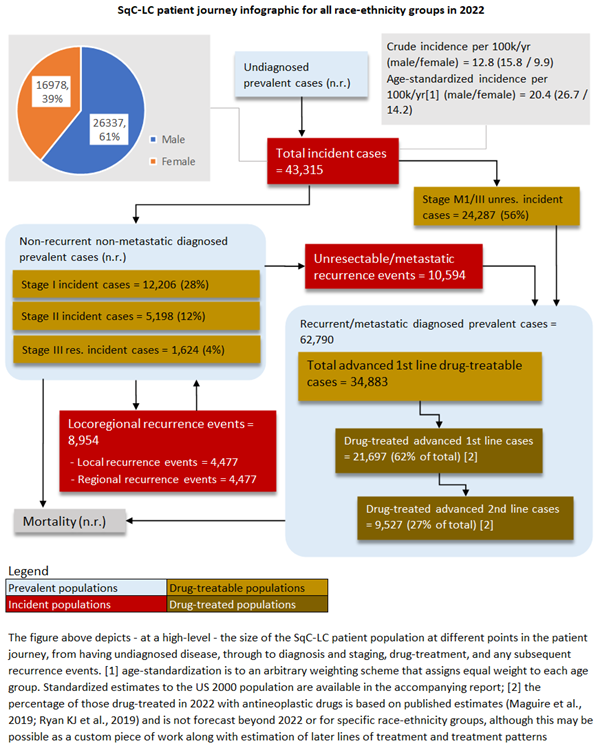The Cancer Populations USA report series provides detailed descriptive epidemiology estimates, forecast out to 20 years, and insights, to support clinical trial design and enrolment, market opportunity assessment and post-marketing authorization activities.
Cancer Populations USA is unique in routinely stratifying key cancer populations by race and ethnicity, which can be used to assess the representativeness of clinical trial populations, as well as identify areas of health inequities between different race-ethnicity population groups.
All estimates in this report are based on nationally representative datasets, such as population-based cancer registries, large epidemiological studies and published national population forecasts. Modelled estimates are based on the best practice industry methods to estimate recurrence events and, where required, make imputations and extrapolations.
The analyst provides estimates for the year 2022 and forecast estimates to 2032 and 2042 in the main body of this report. Annualized forecast estimates are provided in supplementary tables at the end of the report, and also in the accompanying data dashboard, if purchased.
Stratification of incident cases by stage is based on the scheme specified by the American Joint Committee on Cancer (AJCC) 8th edition (i.e. stage groups I, IIA, IIB, IIC, IIIA, IIIB, IIIC, ). Due to small numbers, some stage groups have been aggregated in this report. Wherever possible, this has been into meaningful groupings based on recommended clinical practice (NCCN, 2023).
In this report on squamous-cell lung cancer (SqC-LC), forecast estimates are provided of incident cases by stage, age and gender, race-ethnicity, anatomical subsite, and PD-1/PD-L1 status. Additionally, the author forecasts those cases each year that become eligible for 1st line treatment for advanced disease, which is further stratified by oncogene driver mutations and amplifications.
The analyst's forecast model uses a proprietary algorithm taking account of historical trends, long-term evolution - at the age- and gender-specific level within each race-ethnicity group - in the size and composition of the national population at risk, and inter-generational trends in exposures to both known and unknown risk factors. In addition to national estimates, the publisher also estimates the state-specific size of key populations for the year 2022 for almost all US states, and Puerto Rico, with corresponding heat maps and tabulated results.
All of the key populations included in the report are also reported for each year of the forecast period, along with interactive tables, patient journey diagrams and heat maps, in the accompanying data dashboard.
Purchase of the report and dashboard comes with 12 months client support, with guaranteed response to client queries within 1 working day. The Cancer Populations USA report series is available for a wide range of tumors, both solid tumors and hematological malignancies. Similar reports can be provided for other indications (including non-oncology indications), or for other country(s).
Table of Contents
Executive Summary
Nationally, the analyst estimates 43,315 newly diagnosed incident cases of Squamous-cell lung cancer (SqC-LC) in 2022, of which 44% were initially diagnosed at stages of disease amenable to definitive treatment.
It is estimated that 34,883 advanced 1st line drug-treatable cases nationally in 2022. Of these, estimates show 21,697 (62%) are drug-treated at 1st line, and 9,527 (27%) drug-treated at 2nd line.
Nationally, the number of incident cases over our 20-year forecast period will increase by 10%.
When considering trends in the risk of SqC-LC within each race-ethnicity group, according to the forecast model, the crude incidence rate across the national population will remain relatively constant, from an estimated 13.3 per 100,000 per year in 2022 to 12.6 per 100,000 per year in 2042.
The age-adjusted risk of SqC-LC is highest among black non-Hispanics. The risk of SqC-LC is lower among females than in males.









